Research on the Method of Rainfall Field Retrieval Based on the Combination of Earth–Space Links and Horizontal Microwave Links
Abstract
:1. Introduction
- (1)
- A method for detecting rainfall by combining multiple sources of microwave links is proposed. We built a rainfall detection network for retrieving rainfall fields in combination with ESLs and HMLs, and we validated the significant potential of the method to retrieve high-precision rainfall fields using the HYCELL model and real rainfall fields.
- (2)
- The OK algorithm and RBF neural network are applied to the joint network to retrieve rainfall fields. The results indicate that the joint networks of ESLs and HMLs based on the OK algorithm and RBF neural network can both retrieve the distribution characteristics of rainfall accurately. Moreover, the overall performance of the RBF neural network is better than that of the OK algorithm.
2. Principles of Rainfall Field Retrieval by ESLs and HMLs
2.1. Principle of Rainfall Retrieval by ESL
2.2. Principle of Rainfall Retrieval by HML
2.3. Rainfall Field Retrieval by Combined ESLs and HMLs
2.3.1. Rainfall Field Reconstruction by OK Algorithm
2.3.2. Rainfall Field Reconstruction by RBF Neural Network
- (1)
- The Gaussian function is used as the hidden layer RBF and is given by
- (2)
- The K-means clustering is used to determine the network cluster center Cn and the width of the Gaussian function σn.
- (3)
- The learning rate of the RBF neural network is set to 0.01, and the minimum error requirement of the objective function and the maximum number of iterations are set to 0.01 mm/h and 5000 times, respectively. The training will be stopped automatically if the minimum error requirement is reached during the training process.
- (4)
- The RBF neural network can automatically add the number of hidden units until the training error requirement is reached.
3. Design of the Joint Network of ESLs and HMLs
- (1)
- The links for ESLs and HMLs should be spread as evenly as possible across the area.
- (2)
- The rain rate measured by the link represents the average rain rate over the path and can be considered as the rain rate at the location of the midpoint of the link.
- (3)
- Although rain attenuation is more likely to occur for ESLs and HMLs with long distances, the distribution of real rainfall over the area is not uniform. Thus, the long links have poor spatial representation. To improve the spatial representation of rainfall retrieved by ESLs and HMLs, it is necessary to build short links (the link lengths in this experiment are in the range of 2.8–7.6 km).
- (4)
- The antennas of ESLs, transmitters and receivers of HMLs cannot be installed on the water surface. However, the links can pass above the water surface.
4. Results and Discussion
4.1. Rain Cell Retrieval by Network of ESLs and HMLs
4.2. Performance of Retrieving Real Rainfall Field
5. Conclusions
- (1)
- For the HYCELL model, the joint network of ESLS and HMLs is able to retrieve the distribution of rain rates in rain cells with high accuracy. The RMSE and MB of the OK algorithm for retrieval of the different rain cells are lower than 0.75 mm/h and 0.14 mm/h, respectively, and the CC of the retrieved results is above 0.985. In contrast, the RMSE and MB of the RBF neural network are lower than 0.69 mm/h and 0.29 mm/h, respectively, and the CC of the retrieved rain cells is higher than 0.994. Moreover, the structural distribution of the rain cells retrieved by the RBF neural network is generally in better consistency with the initial rain cells.
- (2)
- For the rainfall from CMORPH, the joint network of ESLs and HMLs can accurately retrieve the rain rates of the real rainfall fields. In particular, the error and correlation of the RBF neural network in retrieving the rain rates from the real rainfall field are better than those of the OK algorithm. However, the performance of the RBF neural network in retrieving the average rain rate is inferior to that of the OK algorithm, and the rain rates would be underestimated for retrieving extreme rainfall.
- (3)
- The joint network of ESLs and HMLs also shows a good performance in monitoring actual rainfall event. The results for stratiform rainfall and convective rainfall retrieved by the joint network based on the OK algorithm and the RBF neural network are substantially consistent with the distribution of actual rainfall events, and they show correctly the characteristics of stratiform rainfall and convective rainfall. Moreover, the approach of the RBF neural network performs better for the retrieval of actual rainfall events.
Author Contributions
Funding
Data Availability Statement
Acknowledgments
Conflicts of Interest
References
- Konapala, G.; Mishra, A.K.; Wada, Y.; Mann, M.E. Climate change will affect global water availability through compounding changes in seasonal precipitation and evaporation. Nat. Commun. 2020, 11, 3044. [Google Scholar] [CrossRef] [PubMed]
- Muller, C.L.; Chapman, L.; Johnston, S.; Kidd, C.; Illingworth, S.; Foody, G.; Overeem, A.; Leigh, R.R. Crowdsourcing for climate and atmospheric sciences: Current status and future potential. Int. J. Climatol. 2015, 35, 3185–3203. [Google Scholar] [CrossRef] [Green Version]
- Gragnani, G.L.; Colli, M.; Tavanti, E.; Caviglia, D.D. Advanced Real-Time Monitoring of Rainfall Using Commercial Satellite Broadcasting Service: A Case Study. Sensors 2021, 21, 691. [Google Scholar] [CrossRef] [PubMed]
- Blandine, B.; Rieckermann, J.; Berne, A. Quality control of rain gauge measurements using telecommunication microwave links. J. Hydrol. 2013, 492, 15–23. [Google Scholar]
- McCabe, M.F.; Rodell, M.; Alsdorf, D.E.; Miralles, D.G.; Uijlenhoet, R.; Wagner, W.; Lucieer, A.; Houborg, R.; Verhoest, N.E.C.; Franz, T.E.; et al. The Future of Earth Observation in Hydrology. Hydrol. Earth Syst. Sc. 2017, 21, 3879–3914. [Google Scholar] [CrossRef] [PubMed] [Green Version]
- Liu, X.C.; Gao, T.C.; Liu, L. A comparison of rainfall measurements from multiple instruments. Atmos. Meas. Tech. 2013, 6, 1585–1595. [Google Scholar] [CrossRef] [Green Version]
- Qingwei, Z.; Yun, Z.; Hengchi, L.; Yanqiong, X.; Taichang, G.; Lifeng, Z.; Chunming, W.; Yanbin, H. Microphysical Characteristics of Precipitation during Pre-monsoon, Monsoon, and Post-monsoon Periods over the South China Sea. Adv. Atmos. Sci. 2019, 36, 1103–1120. [Google Scholar]
- Matrosov, S. Dual-frequency radar ratio of nonspherical atmospheric hydrometeors. Geophys. Res. Lett. 2005, 32, L13816. [Google Scholar] [CrossRef] [Green Version]
- Getirana, A.; Kirschbaum, D.B.; Mandarino, F.; Ottoni, M.; Arsenault, K. Potential of GPM IMERG Precipitation Estimates to Monitor Natural Disaster Triggers in Urban Areas: The Case of Rio de Janeiro, Brazil. Remote Sens. 2020, 12, 4095. [Google Scholar] [CrossRef]
- Xichuan, L.; Binsheng, H.; Shijun, Z.; Shuai, H.; Lei, L. Comparative measurement of rainfall with a precipitation micro-physical characteristics sensor, a 2D video disdrometer, an OTT PARSIVEL disdrometer, and a rain gauge. Atmos. Res. 2019, 229, 100–114. [Google Scholar]
- Tr Mel, S.; Ziegert, M.; Ryzhkov, A.V.; Chwala, C.; Simmer, C. Using Microwave Backhaul Links to Optimize the Performance of Algorithms for Rainfall Estimation and Attenuation Correction. J. Atmos. Ocean. Technol. 2014, 31, 1748–1760. [Google Scholar] [CrossRef]
- Hagit, M.; Artem, Z.; Pinhas, A. Environmental Monitoring by Wireless Communication Networks. Science 2006, 312, 713. [Google Scholar]
- Barthès, L.; Mallet, C. Rainfall measurement from the opportunistic use of an Earth–space link in the Ku band. Atmos. Meas. Tech. 2013, 6, 2181–2193. [Google Scholar] [CrossRef] [Green Version]
- Arslan, C.H.; Aydin, K.; Urbina, J.; Dyrud, L.P. Rainfall measurements using satellite downlink attenuation. In Proceedings of the 2014 IEEE Geoscience and Remote Sensing Symposium, Quebec City, QC, Canada, 13–18 July 2014; pp. 4111–4114. [Google Scholar]
- Song, K.; Liu, X.; Gao, T. Potential Application of Using Smartphone Sensor for Estimating Air Temperature: Experimental Study. IEEE Internet Things 2021, 1. [Google Scholar] [CrossRef]
- Overeem, A.; Leijnse, H.; Uijlenhoet, R. Country-wide rainfall maps from cellular communication networks. Proc. Natl. Acad. Sci. USA 2013, 110, 2741–2745. [Google Scholar] [CrossRef] [Green Version]
- Overeem, A.; Leijnse, H.; Uijlenhoet, R. Retrieval algorithm for rainfall mapping from microwave links in a cellular communication network. Atmos. Meas. Tech. 2016, 9, 2425–2444. [Google Scholar] [CrossRef] [Green Version]
- Berne, A.; Uijlenhoet, R. Path-averaged rainfall estimation using microwave links: Uncertainty due to spatial rainfall variability. Geophys. Res. Lett. 2007, 34, L7403. [Google Scholar] [CrossRef] [Green Version]
- Zinevich, A.; Messer, H.; Alpert, P. Prediction of rainfall intensity measurement errors using commercial microwave communication links. Atmos. Meas. Tech. 2010, 3, 2535–2577. [Google Scholar] [CrossRef] [Green Version]
- Pu, K.; Liu, X.; He, H. Wet Antenna Attenuation Model of E-Band Microwave Links Based on the LSTM Algorithm. IEEE Antenn. Wirel. Propag. 2020, 19, 1586–1590. [Google Scholar] [CrossRef]
- Pu, K.; Liu, X.; Xian, M.; Gao, T. Machine Learning Classification of Rainfall Types Based on the Differential Attenuation of Multiple Frequency Microwave Links. IEEE Trans. Geosci. Remote. 2020, 58, 6888–6899. [Google Scholar] [CrossRef]
- Song, K.; Liu, X.; Gao, T.; He, B. Raindrop Size Distribution Retrieval Using Joint Dual-Frequency and Dual-Polarization Microwave Links. Adv. Meteorol. 2019, 2019, 7251870. [Google Scholar] [CrossRef]
- Han, C.; Huo, J.; Gao, Q.; Su, G.; Wang, H. Rainfall Monitoring Based on Next-Generation Millimeter-Wave Backhaul Technologies in a Dense Urban Environment. Remote Sens. 2020, 12, 1045. [Google Scholar] [CrossRef] [Green Version]
- Zinevich, A.; Messer, H.; Alpert, P. Frontal Rainfall Observation by a Commercial Microwave Communication Network. J. Appl. Meteorol. Clim. 2009, 48, 1317–1334. [Google Scholar] [CrossRef]
- Goldshtein, O.; Messer, H.; Zinevich, A. Rain Rate Estimation Using Measurements From Commercial Telecommunications Links. IEEE Trans. Signal Proces. 2009, 57, 1616–1625. [Google Scholar] [CrossRef]
- Zinevich, A.; Alpert, P.; Messer, H. Estimation of rainfall fields using commercial microwave communication networks of variable density. Adv. Water Resour. 2008, 31, 1470–1480. [Google Scholar] [CrossRef]
- Mugnai, C.; Cuccoli, F.; Sermi, F. Rainfall estimation with a commercial tool for satellite internet in Ka band: Concept and preliminary data analysis. In Proceedings of the SPIE, Remote sensing for Agriculture, Ecosystems, and Hydrology XVI, Amsterdam, The Netherlands, 29 October 2014; Volume 9239. [Google Scholar]
- Xian, M.; Liu, X.; Yin, M.; Song, K.; Zhao, S.; Gao, T. Rainfall Monitoring Based on Machine Learning by Earth-Space Link in the Ku Band. IEEE J. Sel. Top. Appl. Earth Obs. Remote Sens. 2020, 13, 3656–3668. [Google Scholar] [CrossRef]
- Giannetti, F.; Moretti, M.; Reggiannini, R.; Vaccaro, A. The NEFOCAST System for Detection and Estimation of Rainfall Fields by the Opportunistic Use of Broadcast Satellite Signals. IEEE Aerosp. Electron. Syst. Mag. 2019, 34, 16–27. [Google Scholar] [CrossRef]
- Giro, R.A.; Luini, L.; Riva, C.G. Rainfall Estimation from Tropospheric Attenuation Affecting Satellite Links. Information 2020, 11, 11. [Google Scholar] [CrossRef] [Green Version]
- Xian, M.; Liu, X.; Gao, T. An Improvement to Precipitation Inversion Model Using Oblique Earth–Space Link Based on the Melting Layer Attenuation. IEEE Trans. Geosci. Remote. 2021, 59, 6451–6465. [Google Scholar] [CrossRef]
- Zhao, Y.; Liu, X.; Xian, M.; Gao, T. Statistical Study of Rainfall Inversion Using the Earth-Space Link at the Ku Band: Optimization and Validation for 1 Year of Data. IEEE J. Sel. Top. Appl. Earth Obs. Remote Sens. 2021, 14, 9486–9494. [Google Scholar] [CrossRef]
- Lu, X.; Xi, S.; Huang, D.D.; Feng, X.; Wang, W. Tomographic reconstruction of rainfall fields using satellite communication links. In Proceedings of the 2017 23rd Asia-Pacific Conference on Communications (APCC), Perth, WA, USA, 11–13 December 2017. [Google Scholar]
- Xian, M.; Liu, X.; Song, K.; Gao, T. Reconstruction and Nowcasting of Rainfall Field by Oblique Earth-Space Links Network: Preliminary Results from Numerical Simulation. Remote Sens. 2020, 12, 3598. [Google Scholar] [CrossRef]
- Csurgai-Horváth, L. Small Scale Rain Field Sensing and Tomographic Reconstruction with Passive Geostationary Satellite Receivers. Remote Sens. 2020, 12, 4161. [Google Scholar] [CrossRef]
- Colli, M.; Cassola, F.; Martina, F.; Trovatore, E.; Delucchi, A.; Maggiolo, S.; Caviglia, D.D. Rainfall Fields Monitoring Based on Satellite Microwave Down-Links and Traditional Techniques in the City of Genoa. IEEE Trans. Geosci. Remote. 2020, 58, 6266–6280. [Google Scholar] [CrossRef]
- Levchenko, I.G.A.B.; Xu, S.A.C.; Wu, Y.C.D.; Bazaka, K.E. Hopes and concerns for astronomy of satellite constellations. Nat. Astron. 2020, 4, 1012–1014. [Google Scholar] [CrossRef]
- Giannetti, F.; Reggiannini, R.; Moretti, M.; Adirosi, E.; Baldini, L.; Facheris, L.; Antonini, A.; Melani, S.; Bacci, G.; Petrolino, A.; et al. Real-Time Rain Rate Evaluation via Satellite Downlink Signal Attenuation Measurement. Sensors 2017, 17, 1864. [Google Scholar] [CrossRef] [PubMed]
- Shen, X.; Huang, D.D.; Wang, W.; Prein, A.F.; Togneri, R. Retrieval of Cloud Liquid Water Using Microwave Signals from LEO Satellites: A Feasibility Study through Simulations. Atmosphere 2020, 11, 460. [Google Scholar] [CrossRef]
- ITU-R. Recommendation P.838-3 Specific Attenuation Model for Rain for Use in Prediction Methods. Technical Report. 2005. Available online: https://www.itu.int/dms_pubrec/itu-r/rec/p/R-REC-P.838-3-200503-I!!PDF-E.pdf (accessed on 15 January 2022).
- ITU-R. Recommendation P.839-4 Rain Height Model for Prediction Methods. Technical Report. 2019. Available online: https://www.itu.int/dms_pubrec/itu-r/rec/p/R-REC-P.839-4-201309-I!!PDF-E.pdf (accessed on 15 January 2022).
- Song, K.; Gao, T.C.; Liu, X.C.; Min, Y.; Yang, X. Method and experiment of path rainfall intensity inversion using a microwave link based on nonspherical rain-induced model. Acta Phys. Sin.-Chin. Ed. 2017, 66, 154. [Google Scholar] [CrossRef]
- Olsen, R.L. The aRb relation in the calculation of rain attenuation. IEEE Trans. 1978, 26, 318–329. [Google Scholar] [CrossRef]
- Dowd, P.A. The Variogram and Kriging: Robust and Resistant Estimators. In Geostatistics for Natural Resources Characterization; Springer: Dordrecht, The Netherlands, 1984. [Google Scholar]
- Lark, R.M. Geostatistics for Environmental Scientists. J. R. Stat. Soc. A Stat. 2001, 52, 526. [Google Scholar] [CrossRef]
- Jiang, Q.; Zhu, L.; Aemail, C.S.C.C.; Sekar, V. An efficient multilayer RBF neural network and its application to regression problems. Neural. Comput. Appl. 2022, 34, 4133–4150. [Google Scholar] [CrossRef]
- Rodriguez-Iturbe, I.; Eagleson, P.S. Mathematical models of rainstorm events in space and time. Water Resour. Res. 2010, 23, 181–190. [Google Scholar] [CrossRef] [Green Version]
- Sauvageot, H.; Mesnard, F.; Tenório, R.S. The Relation between the Area-Average Rain Rate and the Rain Cell Size Distribution Parameters. J. Atmos. Sci. 2010, 56, 57–70. [Google Scholar] [CrossRef]
- Tournadre, J.; Quilfen, Y. Impact of rain cell on scatterometer data: 1. Theory and modeling. J. Geophys. Res. Part C Ocean. 2003, 108, 3225. [Google Scholar] [CrossRef]
- Feral, L.; Sauvageot, H.; Castanet, L.; Lemorton, J. HYCELL—A new hybrid model of the rain horizontal distribution for propagation studies. I. Modeling of the rain cell. Radio Sci. 2003, 38, 21–22. [Google Scholar] [CrossRef] [Green Version]
- Joyce, R.J.; Janowiak, J.E.; Arkin, P.A.; Xie, P. CMORPH: A Method that Produces Global Precipitation Estimates from Passive Microwave and Infrared Data at High Spatial and Temporal Resolution. J. Hydrometeorol. 2004, 5, 287–296. [Google Scholar] [CrossRef]
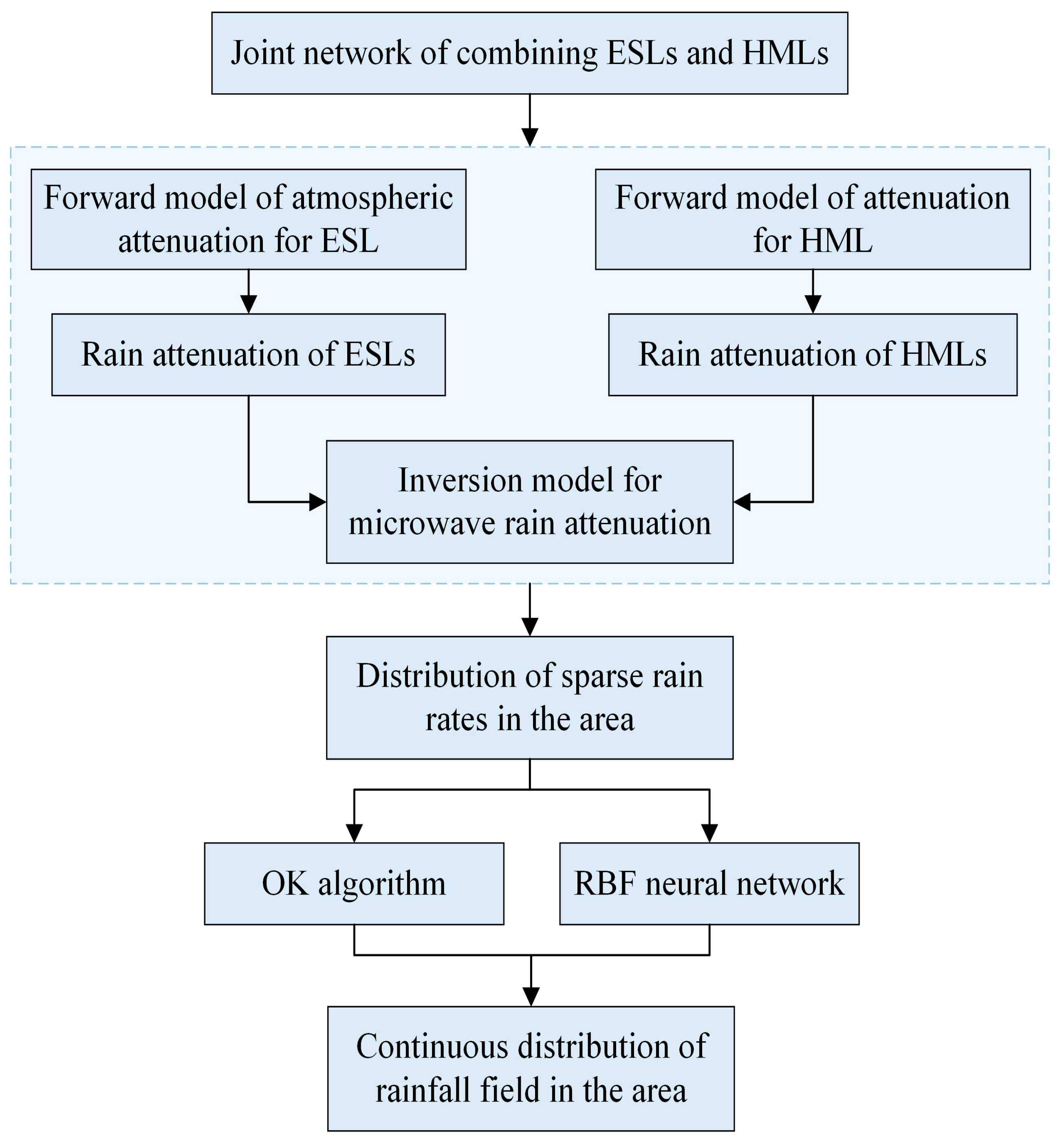
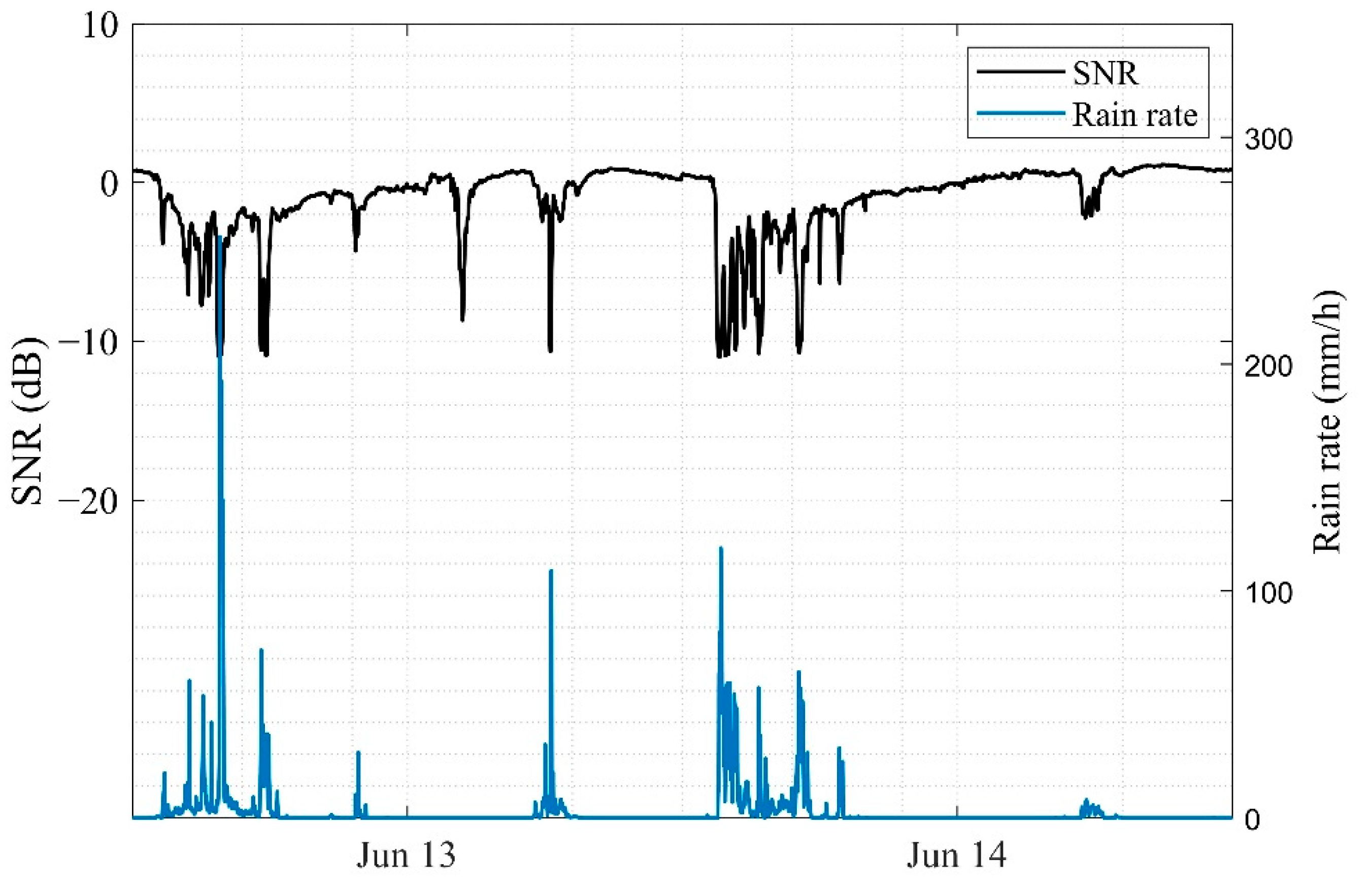
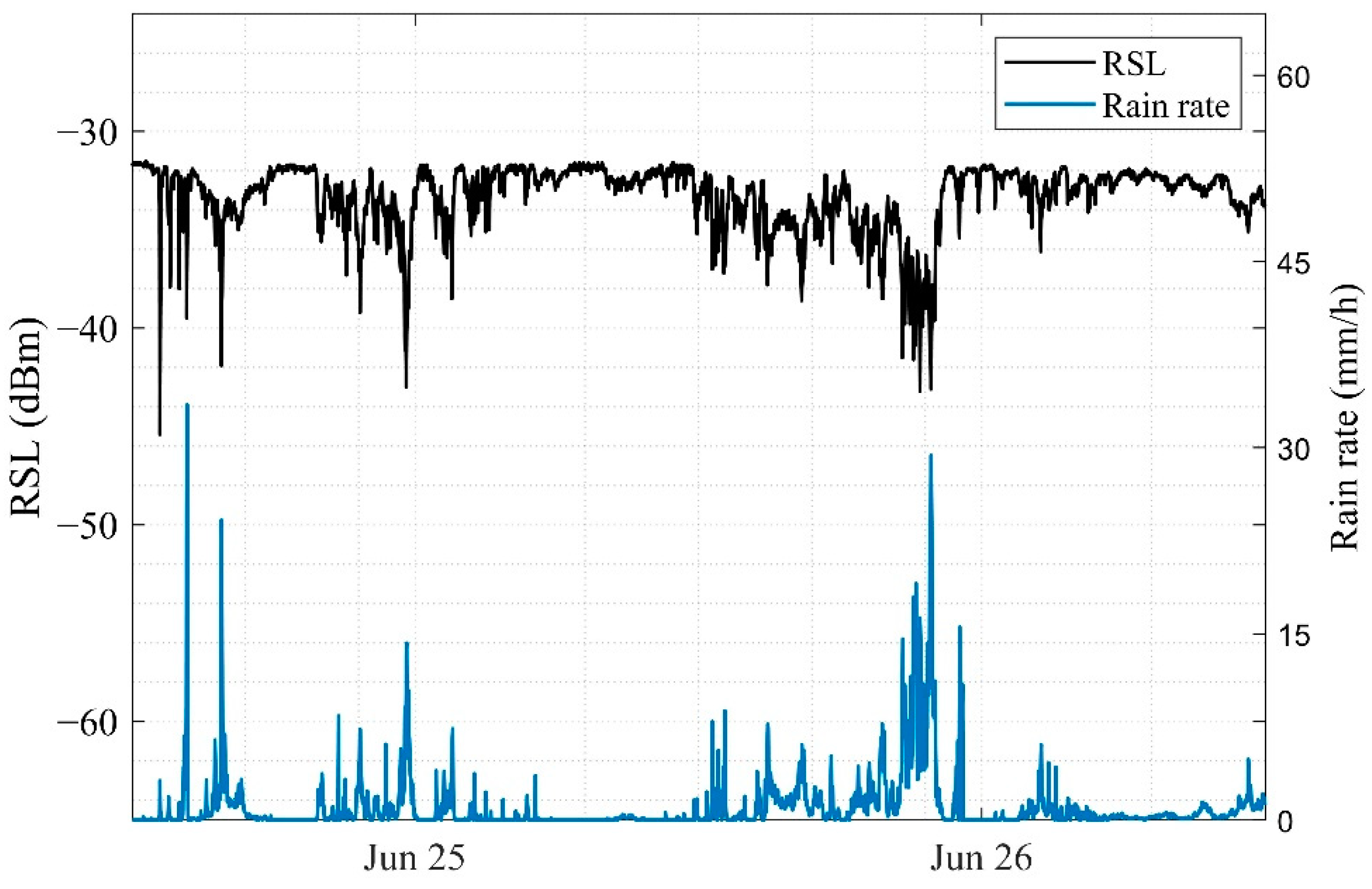
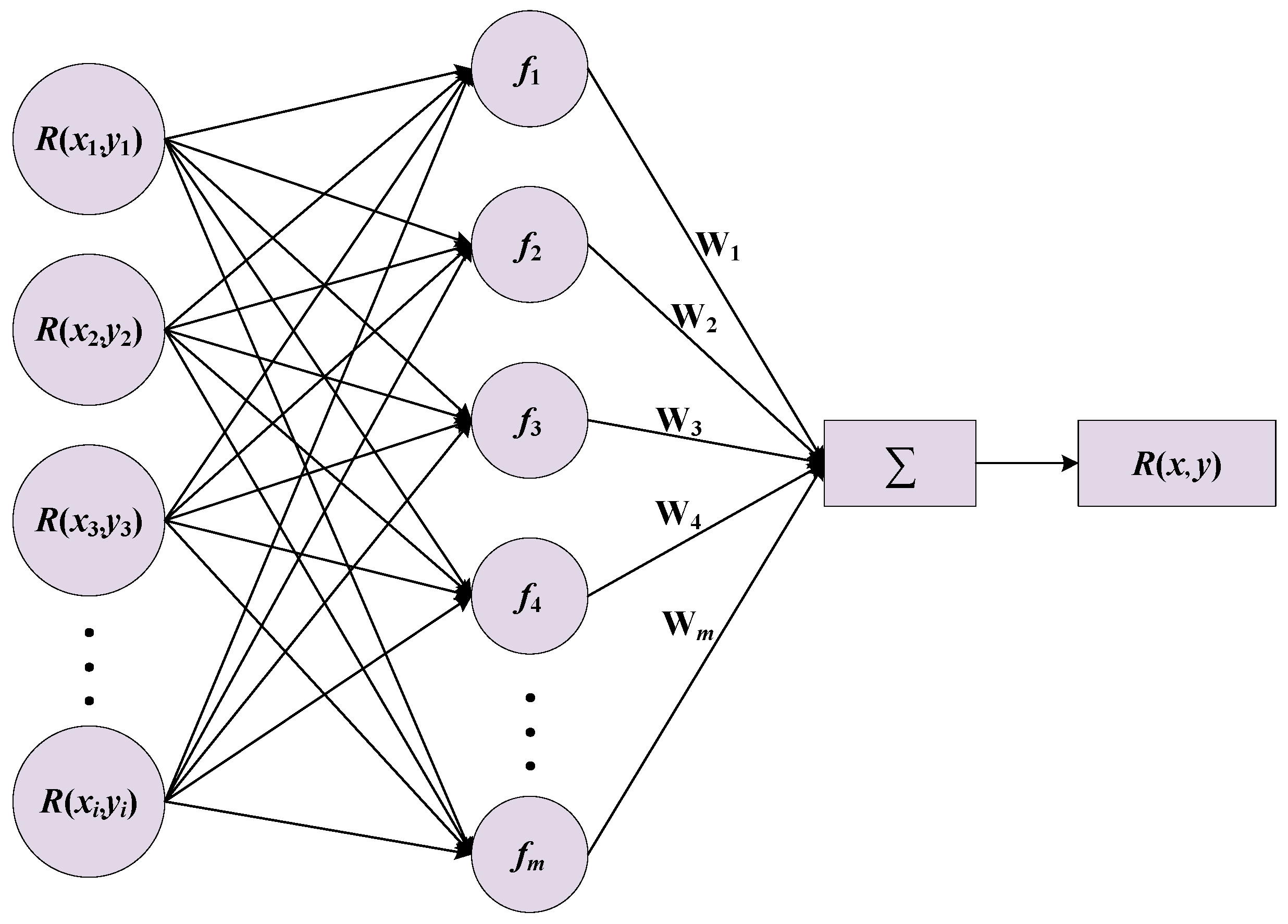
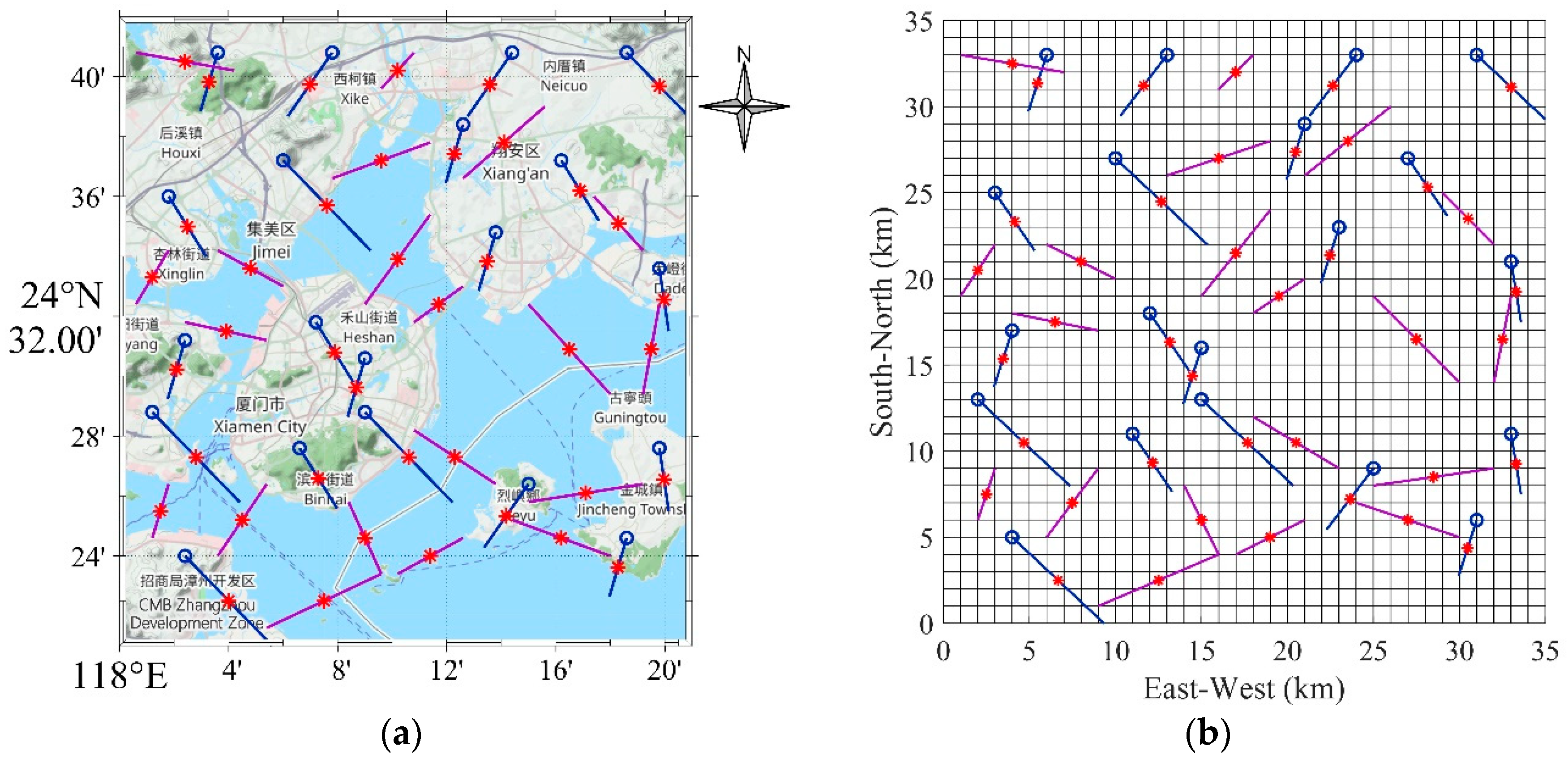


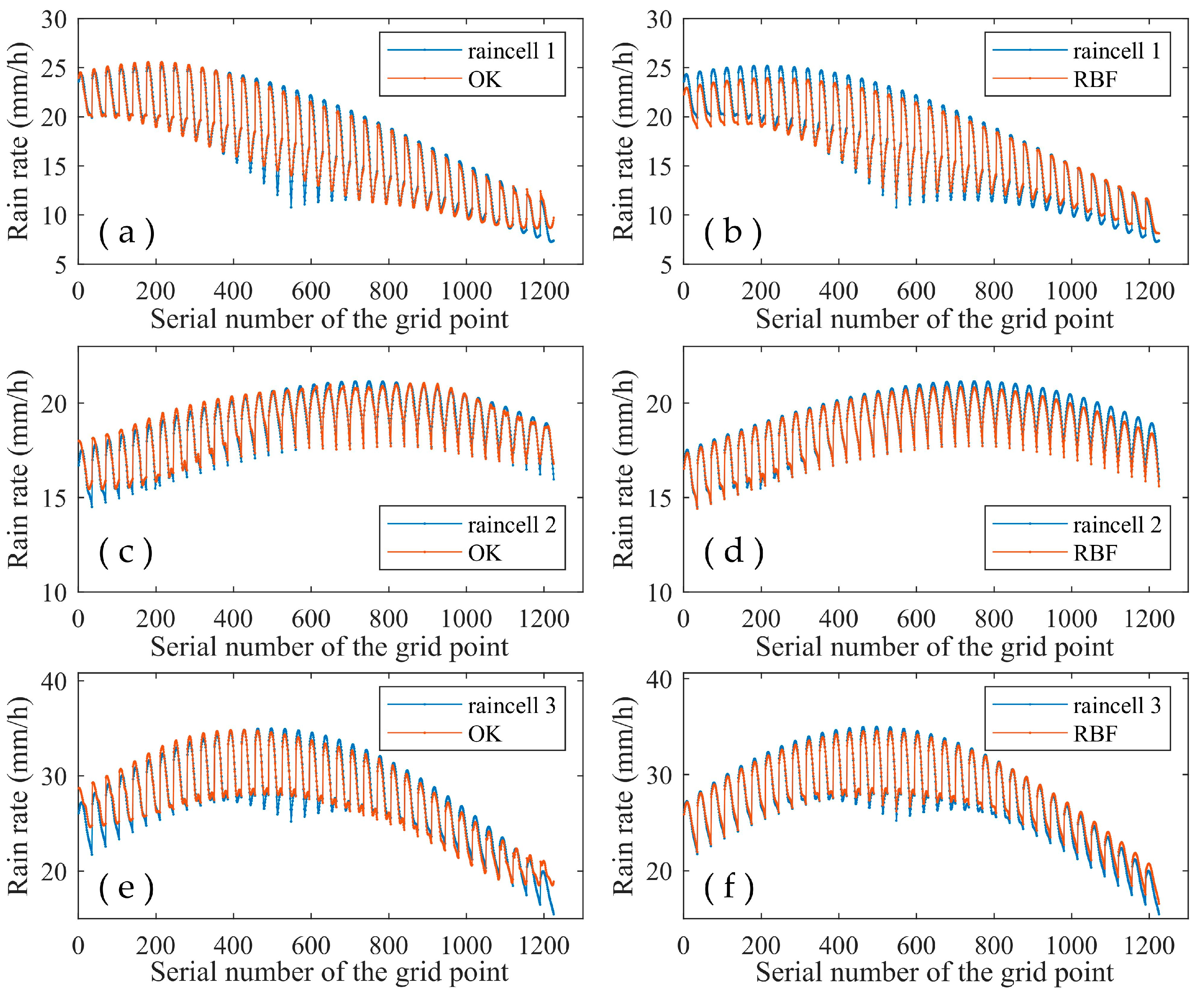
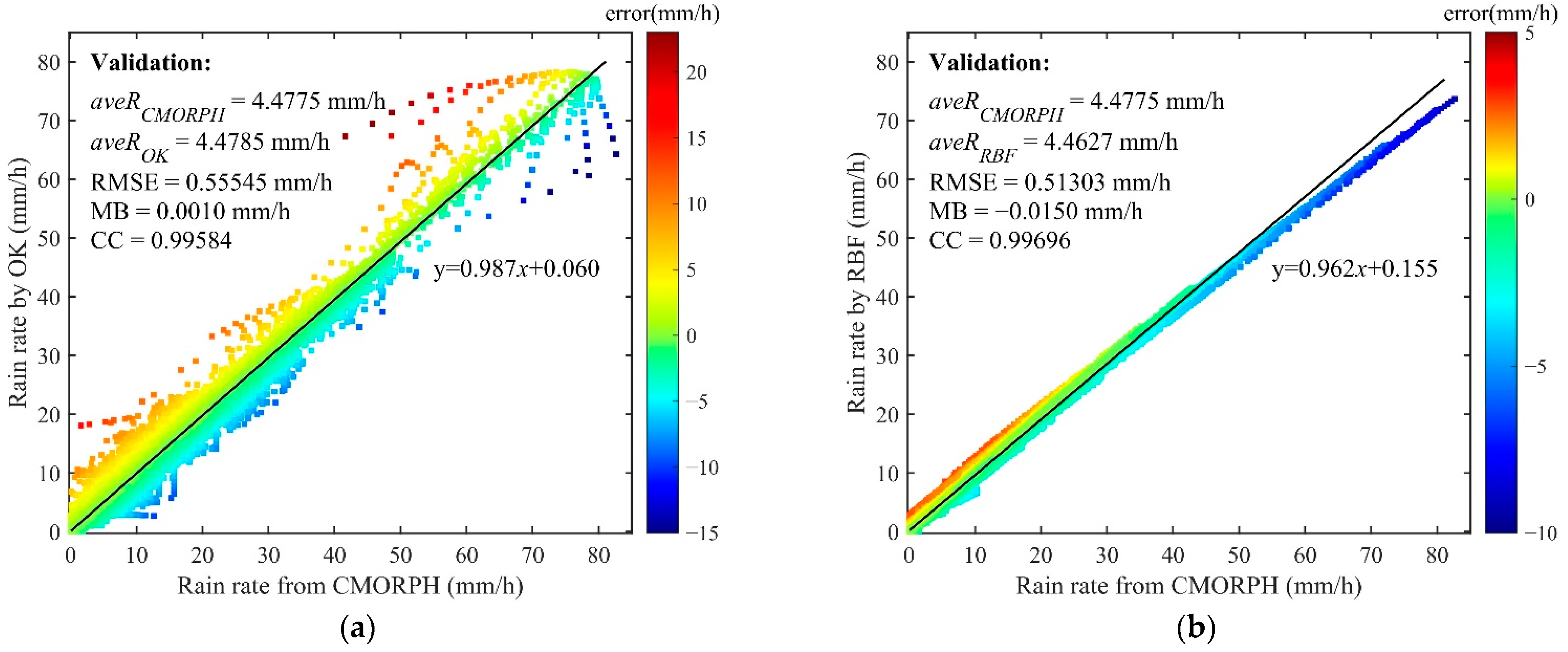
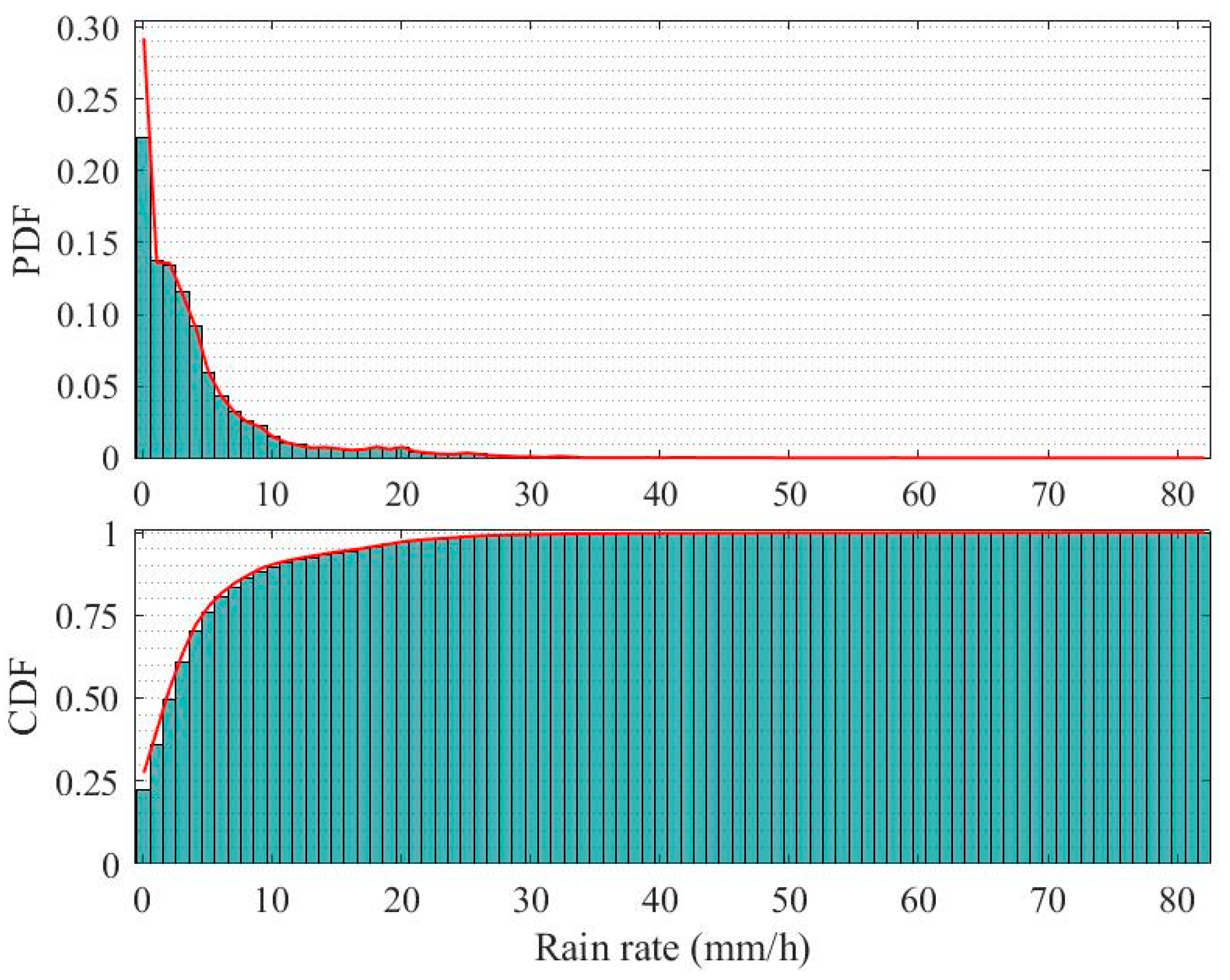
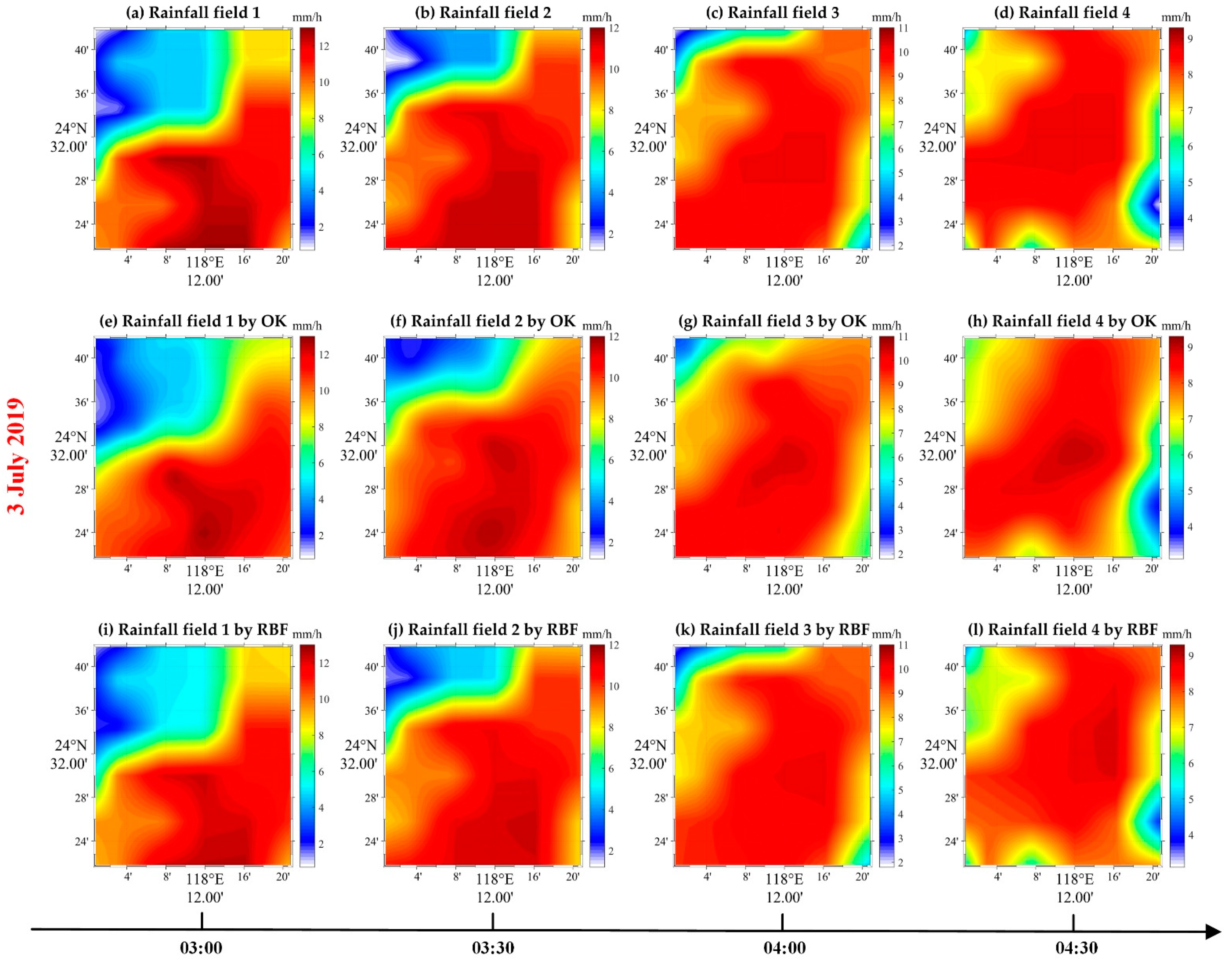
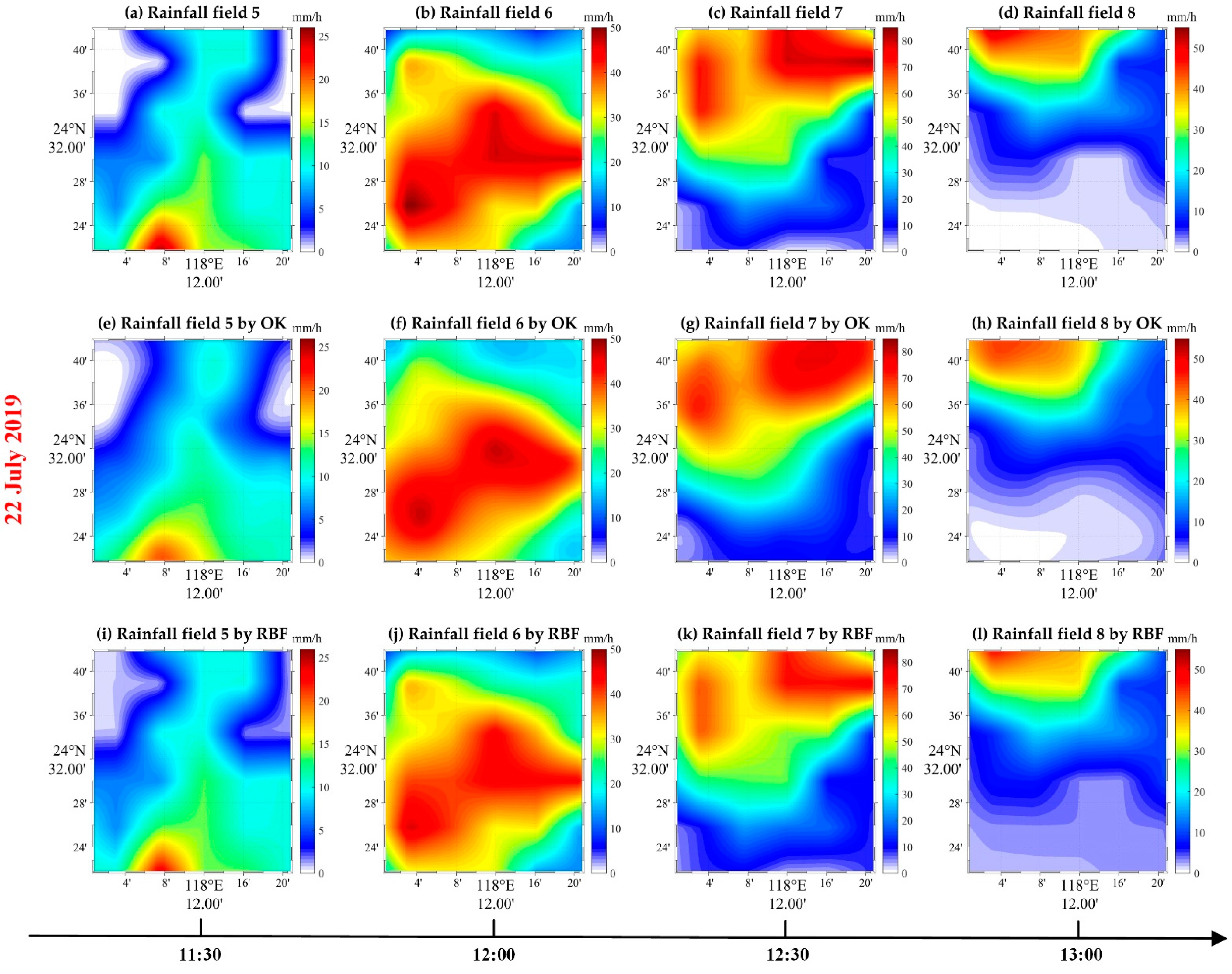
| Satellites | Longitude | Elevation (°) | Azimuth (°) | Frequency (GHz) |
|---|---|---|---|---|
| Apstar9 | 142.0°E | 50.86 | 133.13 | 11.154 |
| Apstar6C | 134.0°E | 56.28 | 145.56 | 12.323 |
| AsiaSat9 | 122.0°E | 61.04 | 170.75 | 12.726 |
| ChinaSat10 | 110.5°E | 60.10 | 197.94 | 12.309 |
| AsiaSat5 | 100.5°E | 55.19 | 217.51 | 12.460 |
| Rain Rate | Parameters | Range |
|---|---|---|
| R1 < R < R2 | RE | 10–100 mm/h |
| aE | 0.5–35 km | |
| bE | 0.5–35 km | |
| R > R2 | RG | 10–80 mm/h |
| aG | 0.5–35 km | |
| bG | 0.5–35 km |
| Rain Cells | RMSE (mm/h) | MB (mm/h) | CC | |||
|---|---|---|---|---|---|---|
| OK | RBF | OK | RBF | OK | RBF | |
| Rain cell 1 | 0.52 | 0.69 | −0.14 | −0.12 | 0.995 | 0.999 |
| Rain cell 2 | 0.27 | 0.28 | 0.03 | −0.20 | 0.986 | 0.994 |
| Rain cell 3 | 0.75 | 0.54 | 0.02 | 0.29 | 0.985 | 0.998 |
| Rainfall Type | Rainfall Fields | RMSE (mm/h) | MB (mm/h) | CC | |||
|---|---|---|---|---|---|---|---|
| OK | RBF | OK | RBF | OK | RBF | ||
| Stratiform rainfall | Rainfall field 1 | 0.52 | 0.32 | −0.08 | −0.01 | 0.988 | 0.999 |
| Rainfall field 2 | 0.54 | 0.26 | −0.03 | −0.02 | 0.980 | 0.998 | |
| Rainfall field 3 | 0.42 | 0.23 | −0.01 | −0.04 | 0.964 | 0.990 | |
| Rainfall field 4 | 0.31 | 0.30 | −0.05 | −0.06 | 0.949 | 0.954 | |
| Convective rainfall | Rainfall field 5 | 1.05 | 0.58 | −0.20 | 0.09 | 0.979 | 0.997 |
| Rainfall field 6 | 2.56 | 1.60 | 0.22 | −1.00 | 0.971 | 0.997 | |
| Rainfall field 7 | 4.04 | 3.44 | 1.27 | −1.94 | 0.988 | 0.998 | |
| Rainfall field 8 | 1.75 | 1.73 | 0.47 | 0.62 | 0.992 | 0.998 | |
Publisher’s Note: MDPI stays neutral with regard to jurisdictional claims in published maps and institutional affiliations. |
© 2022 by the authors. Licensee MDPI, Basel, Switzerland. This article is an open access article distributed under the terms and conditions of the Creative Commons Attribution (CC BY) license (https://creativecommons.org/licenses/by/4.0/).
Share and Cite
Zhao, Y.; Liu, X.; Pu, K.; Ye, J.; Xian, M. Research on the Method of Rainfall Field Retrieval Based on the Combination of Earth–Space Links and Horizontal Microwave Links. Remote Sens. 2022, 14, 2220. https://doi.org/10.3390/rs14092220
Zhao Y, Liu X, Pu K, Ye J, Xian M. Research on the Method of Rainfall Field Retrieval Based on the Combination of Earth–Space Links and Horizontal Microwave Links. Remote Sensing. 2022; 14(9):2220. https://doi.org/10.3390/rs14092220
Chicago/Turabian StyleZhao, Yingcheng, Xichuan Liu, Kang Pu, Jin Ye, and Minghao Xian. 2022. "Research on the Method of Rainfall Field Retrieval Based on the Combination of Earth–Space Links and Horizontal Microwave Links" Remote Sensing 14, no. 9: 2220. https://doi.org/10.3390/rs14092220
APA StyleZhao, Y., Liu, X., Pu, K., Ye, J., & Xian, M. (2022). Research on the Method of Rainfall Field Retrieval Based on the Combination of Earth–Space Links and Horizontal Microwave Links. Remote Sensing, 14(9), 2220. https://doi.org/10.3390/rs14092220







